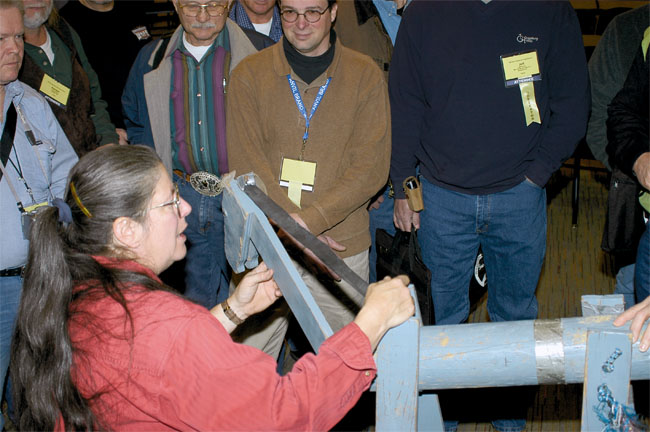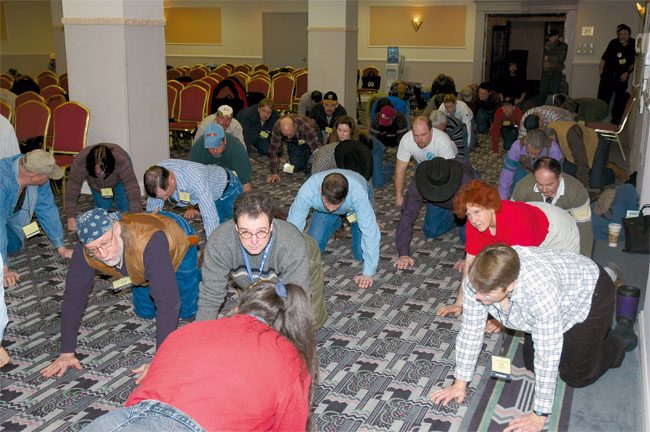If you start assessing a hoof only after picking it up, you might be missing important evidence that helps explain the condition of that foot, according to Deb Bennett. Instead, start the evaluation by watching the horse move and examining its standing posture. Watch for leaning, she says.
Horses tend to lean, usually favoring one side over the other, because of their anatomy, Bennett says. And chronic leaning can help explain hoof wear and growth patterns, including steep walls or differences between right and left hooves on a particular horse, she adds.
Furthermore, farriers who see these effects on the hoof but don’t understand the root cause could end up incorrectly compensating and, in a worst case scenario, harm the horse, she says.
Bennett heads up the Equine Studies Institute in Livingston, Calif. She also is a horse owner and trainer, gives horsemanship clinics and speaks on the equine lecture circuit. She is not a farrier, but has earned a doctoral degree and describes herself as a biomechanic trained in analyzing the structure and movement of horses.
Bennett believes so strongly in the ties between form and function that she told attendees at last winter’s International Hoof-Care Summit that biomechanics could form the basis of a new paradigm for farriery. She describes a paradigm as a set of guiding rules or protocols that pulls together the pieces of farrier knowledge into a system that allows for projections of what will happen as a result of any specific action by a farrier.
“Once you learn how the paradigm works, it becomes a powerful intellectual tool, a brain tool,” she says, adding that the greatest need in the farrier industry is a governing paradigm. She cautions against being stuck in “authority thinking,” essentially doing something the way it’s always been done simply because it’s always been done that way. “You will be left behind,” she warns, because that kind of thinking blocks communication and progress.
She refers to farriers as paramedical professionals, not tradesmen, and she notes that other fields in the medical professions have governing paradigms that allow them to diagnose and treat health issues with a degree of confidence.
Built-In Explanations
Bennett builds her suggested paradigm on the horse’s anatomy, which differs dramatically from that of humans in the way the limbs are attached to the torso. She says understanding a horse’s musculoskeletal system — the muscle and bones — gives farriers insights into why a horse moves the way it does and what that means for the hooves.
She notes that the horse’s front legs are connected to its body by a number of muscle groups. They include the serratus complex, with four muscles in two layers on each side; the pectoral complex, with four branches on each side; and the trapezius rhomboid complex, a comparatively minor group that helps stabilize the chest and forelegs. The combined muscle groups form a sling that is suspended from the inner aspects of the front legs and which holds up the chest, Bennett says.
The bones supporting the area include the vertebrae, scapula, humerus and ribs. In humans, collarbones hold the shoulder away from the chest and force the sternum to stay in the middle of the body, but horses have nothing that compares to the collarbones. “The implications are enormous,” according to Bennett.
“There is no bony socket connection between any portion of the horse’s front legs and his body. It’s loose,” she says. “This gives the horse potentials that we do not have because our forearms are not entirely loose between the forearms and the thorax.”
Loose Ends
Bennet notes that horses also don’t have bony socket hip joints for their back legs. The horse’s leg structure starts with the pelvis.
“The pelvis with all its associated muscles is a huge part of their body, and it’s attached to their back by less than 4 square inches of ligaments. It’s not socketed on there. Their whole hind leg is basically Velcroed onto their spine,” Bennett says. “So the front legs are attached by muscles, and the back legs are attached by Velcro. The bottom line is that the whole system is wobbly and flexible.”
She adds, “It amounts to a cylinder (the chest) mounted on a system that can lean. As the upper part leans, the feet compensate. If the horse leans to the left, the toes will face right. If it leans to the right, the toes point to the left. It works the same for the back legs as well as the front. If the horse leans to the left in front, the hind toes will also go off to the right.”
Bennett defines leaning as standing off plumb. The horse’s head will go to the side opposite the lean, acting as a counter-balance. She says the horse becomes “crooked” when it moves its sternum closer to one of its front legs. When horses aren’t in plumb, they can’t collect and can’t move properly, she adds.
Both legs under the leaning side will bear more weight, she says. “There is a natural inclination to believe that if the horse leans to the left, there will be a diagonal effect and the horse will put more weight on the right hind. But that isn’t true; 99 times out of 100, the horse that leans to the left will overweight the left hind limb as well as the left fore limb. What they do in front, they will almost always do in back,” she says.
The diagonal weight distribution is found occasionally, she says, “But there has to be a hugely overriding reason for it. Some horses do that, but they are twice as lame as the other ones. They are already lame in some other way, and that’s what make them do this.”
The Effects
A horse that chronically leans to one side tends to become weaker on the opposite side. “The law of physics is that wherever the weight is, is where the effort will be. It’s the leg that’s anchored that does the work, the pushing off,” Bennett says.
She notes that it is impossible to lean a square, three-dimensional system without raising it on the side toward which you leaned it. “The same thing happens in the walls of the hooves,” she says. “If the horse chronically leans to the right, the steep walls will be on the right hooves. They typically will be more obviously steep in the front because the front bears more weight and concussion, so anything the horse does shows up more strongly and sooner in the front feet.
“That’s another side effect. Feet that start out cone-shaped become asymmetrical. The axis of that cone will no longer go down the middle of the cone as seen from the front view. The feet and every other body part will reflect the chronic lean,” she says.
She compares a chronically leaning horse to an old car that drives down the road crooked because it needs a front-end tire alignment. “What’s that doing to the tires,” she asks. “They’ll be cupped and bald on one quarter of the tire. It’s the same with horses. If they don’t move plumb to themselves, they damage their limbs. But the out-of-plumbness does not start with the limbs, it starts in the body because the horse is leaning.
“If you don’t address the cause, it will keep happening. If you prevent the upper body from functioning normally, you must expect the feet to function abnormally, too,” she says.
Why It Happens
Bennett believes horses have as much potential to move plumb as they do to lean, but several factors lead them to lean:
- “That’s not how their brain is set up. Horses have their eyes on the sides of their heads, and if they turn their head all the time and approach things with one eye leading, this sets them up to lean in that direction,” she says.
- “Poor standards of horsemanship can cause leaning. The rider and the horse are both out of plumb. The rider may not know how to use his or her legs” to properly control the horse, she adds.
- She says leaning also occurs when the rider has no understanding of biomechanics. “A horse is crooked to the extent that his vertebral column does not track the path that the rider is trying to ride him on. Ninety-five percent of riders who think they are knowledgeable think that when the horse’s spine is straight, their horse is straight.
“They don’t understand that when you change the path, you have to ride the horse with that amount of bend in him. If you ride your horse 5 degrees less bent than the curve you’re on, you’re crooked. For example, to strike off from a walk into a left canter, the first thing the horse has to do is put his weight on his right hind leg. How can he do that if he’s leaning to the left? When you bend him to the left, he leans to the left.”
Although uninformed riders cause many leaning problems, Bennett says better trained riders can actually put leaning to work for the good of rider and horse. “Leaning is not necessarily an enemy. A rider who know these things will immediately begin to see and feel the leaning. Then it is up to the rider to help the horse get out of the pattern of leaning.
“The secret to bending is not only to understand about leaning, but also to actually dictate it. Leaning is not bad per se, it’s only bad when it’s out of control. When it’s under control, it’s a great tool,” she says.
Recognizing Leaners
Bennett tells farriers that a horse is “off” when he’s crooked. “With a horse that appears off, you’ll see feet with weird wear, but you won’t necessarily see a lame horse. He might look like he has Grade 1 lameness. The instant he goes crooked, he will be that much off.”
She also cautions that there are no stand-alone aids for collection. “The same aids that assist you in making the horse straight are the aids for collection,” she says. “Collection is the result, the side-effect, of straightness. As soon as the horse moves straight, he will instantly offer at least the start of collection.”

MODELING FOR MEMORY. Deb Bennett uses a wooden model she calls “Woody” to show the ramifications of loose joints in horses. The model horse features connecting straps that allow more movement than is found in the human body.
A farrier might be able to tip a leaning horse in the other direction by applying modified shoes on the lean-to side, she concedes, “But if you do that, you’re going to cripple him. That is not the real solution.
“You should never shim a horse on one side unless it really does have a leg that is shorter than its others. Then he needs an orthotic, and that is the right treatment for him. Only one time in a thousand cases will you find a horse that actually has one leg or two legs shorter than the others.
“The only time you can justify putting a stack pad under a foot is when it is that much shorter, by measurement, than the other leg. Otherwise, you are giving him a short leg,” Bennett says.
“When the legs are more than a centimeter different in length, which is the limit of what is considered normal variation from left to right, it will stick out so strongly that you won’t miss it. They tip to one side, rather than lean,” she adds.
To correct chronic leaning, it must be understood that weight flows like a liquid, and the flow of the horse’s weight can be controlled by a farrier, trainer or horse owner, according to Bennett.
Corrective Training
The method for eliminating chronic leaning involves moving the inside hind leg under the horse’s body shadow, which will result in flowing the weight to the other side. “This is the single basic knowledge that permits the opening of collection. This control also makes the horse feel submissive,” she says. “Everything else you do on horseback will depend on this. You have to learn how to use the hind leg.”
Bennett would like to see this anatomical paradigm understood by horse owners, trainers and farriers. “I don’t think it’s an adequate education for a farrier to see a dissection of the limb from the knee down,” she says. “I think that engenders false mental pictures, because it doesn’t show you how the limb is attached to the body above.
“This paradigm or model draws all the phenomena together,” she says. “Why does he have a flat foot and a clubby-looking foot? Why does a horse with a high right shoulder also have a high right hip? This explains it.”
Even when exceptions to the rules are found, the farrier can say to himself or herself, “Within the paradigm, the horse should be leaning to the right in back, but it isn’t.
‘Therefore there is something else going on; some other factor interfering. Let’s look for it. This gives you insight and motivates you to look for that mitigating factor,” Bennett says.









Post a comment
Report Abusive Comment